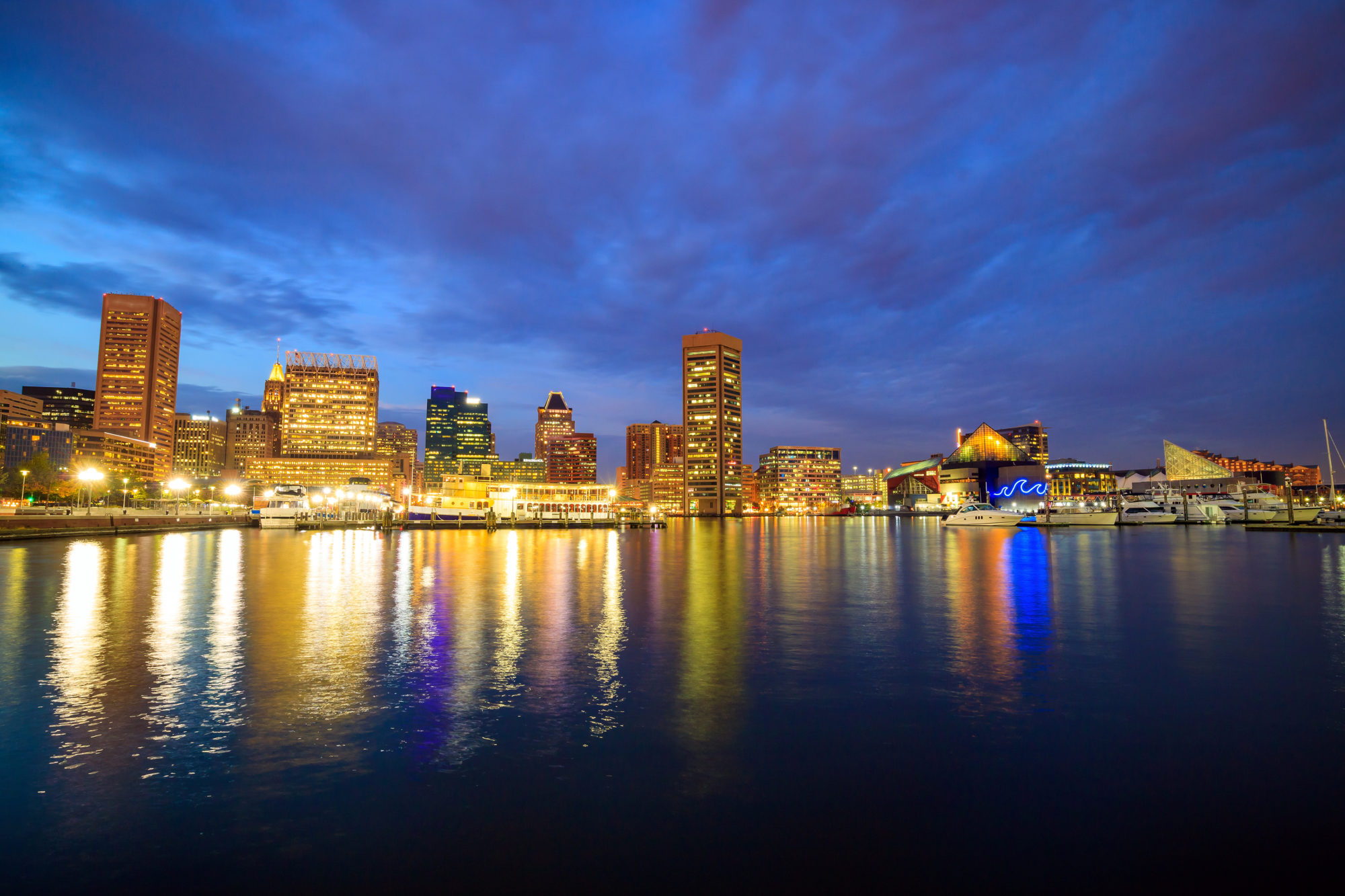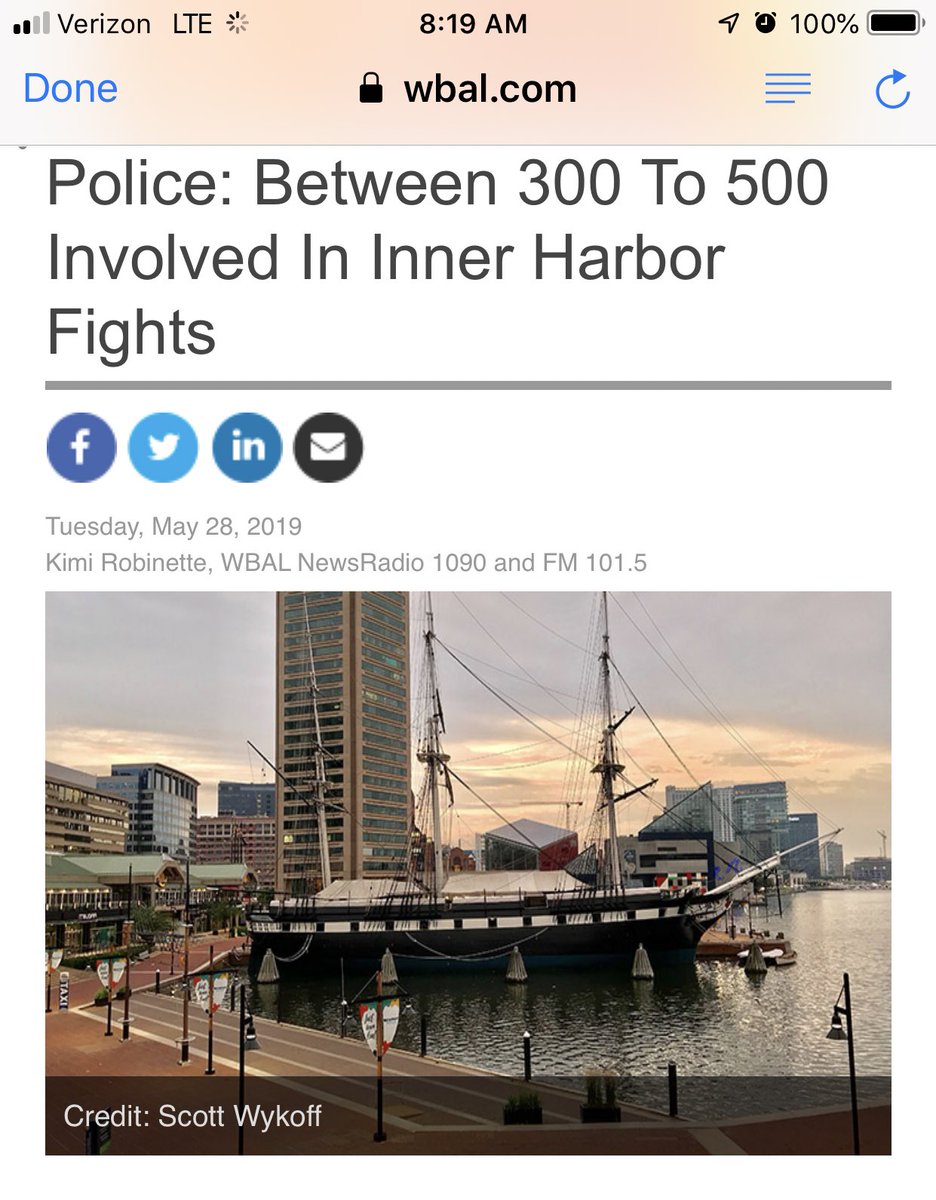Media Frame: Stoking Panic Over ‘Flood’ of ‘Juveniles’ in Baltimore’s Inner Harbor
The sensationalist coverage of a handful of fights highlights local media’s misplaced priorities.

The public’s perception of crime is often significantly out of alignment with the reality. This is caused, in part, by frequently sensationalist, decontextualized media coverage. Media Frame seeks to critique journalism on issues of policing and prisons, challenge the standard media formulas for crime coverage, and push media to radically rethink how they inform the public on matters of public safety.
Over Memorial Day weekend, a handful of fights broke out in Baltimore’s Inner Harbor. Police officers arrested six people and charged them with disorderly conduct, assault, unarmed robbery, and destruction of property. According to the chief of patrol, Col. Richard Worley, no one was seriously injured. And per the Baltimore Sun, the robbery involved “several boys [who] made off with armfuls of snack foods.”
But considering the media’s reaction, one would think the Inner Harbor was total bedlam. Worse, the coverage perpetuated the loaded, racialized language used all too often in local crime reporting, and failed to recognize the broader social forces that make these types of incidents more likely.
From midday May 23 to midday May 30, there were 37 reports about the May 25 Inner Harbor skirmishes or the build-up surrounding the incident from Baltimore’s local media. (We surveyed the four local TV news stations, the Baltimore Sun, and two major radio news stations.) The majority of these reports were written in frantic prose, often exaggerating the scope and severity of the incident.
By early the following week, it seemed as if everyone had a take, no matter how ill-informed. Baltimore Business Journal managing editor Ryan Sharrow breathlessly wrote that the “images of hundreds of unruly teens fighting, jumping on cars and destructing property along the Inner Harbor aren’t easy to forget,” which is odd since only six people were arrested.
A similar conflation by WBAL Radio, in the heat of the media panic, led to this completely inaccurate headline (since deleted after social media criticism):

Baltimore media repeatedly ran headlines that week referring to children as “juveniles,” a loaded police term, or “Copspeak” designed to dehumanize those we would normally call teenagers or kids. A WBAL headline read, “Mayor, City Council President Respond To Juvenile Disturbance At Inner Harbor On Saturday.” Another, on the local CBS affiliate’s website, read, “6 Arrested In Inner Harbor After Reports Of Juveniles Fighting.” WCBM, an AM radio station, reposted a local Fox article, skipping the “Copspeak” and going the more overtly racist route with its headline: “BALTIMORE: Thugs Randomly Beating People and Causing Chaos at Inner Harbor.”
Only a handful of people were arrested, yet hundreds of “juveniles” “descending” on the Inner Harbor is now an indelible image. Journalists and columnists used the word “flood,” too, as one might describe zombies or insects. The Sun ran Dan Rodricks’s column with the headline “Baltimore kids flooding the Inner Harbor: What do you suggest?” (since changed after social media backlash). A news piece at the Sun was headlined “As teens and police flooded Baltimore’s Inner Harbor, bystanders and business owners braced themselves.”
“Look at this language,” Lawrence Brown, an associate professor at Morgan State University in Baltimore, noted on Twitter. “Baltimore kids ‘flooding’ the Inner Harbor. It’s close [to] Trump’s ‘invasion’ of Central American immigrants that suggests that a large crowd of people—by itself—invokes the idea of a disaster.”
Over four years ago, in the wake of Freddie Gray’s death at the hands of police, the city’s media was similarly caught up in the overblown “purge” narrative—a narrative built around a fear of mobs of Black teens causing mindless violence in riots. We later learned that story fell apart upon the most cursory examination, after it was revealed the kids were pinned in by police for hours, unable to use the restroom or take public transportation home.
There is also an obvious racial component to the Inner Harbor coverage. Black teens are depicted as menacing a wealthy, white, tourist-heavy space. This approach is far from uncommon: Studies show American media in general focuses far more on interracial crime over intraracial crime, which makes up the vast majority of crime in the U.S. According to the Center for American Progress: “Black Americans, and black men in particular, are overrepresented as perpetrators of crime in U.S. news media. This is especially true when looking at the incidence of violent crime. For example, one study of late-night news outlets in New York City in 2014 found that the media reported on murder, theft, and assault cases in which black people were suspects at a rate that far outpaced their actual arrest rates for these crimes. The news media also vilifies black people by presenting black crime suspects as more threatening than their white counterparts.”
It’s important to understand the historical context of such reporting. As Brown noted, fears of “Negro Invasions” in Baltimore go back over 100 years. The social contexts are different, but panic over Black people entering white spaces carries centuries of baggage—baggage that reporters ought to note rather than ignore or, at worst, pander to.
And while a spasm of violence in white-majority neighborhoods has triggered wall-to-wall coverage, the media hardly notices when social services to the poor are cut or resources are gutted. Over a six-month period in 2012, the city of Baltimore shut down about 20 youth recreation centers. Yet in the same period, the outlets that have churned out story after story about the Inner Harbor managed to publish only 11 total articles and news segments on the recreation center shutdowns: three in the Baltimore Sun, three segments at WMAR (ABC), one segment at WJZ (CBS), two at WBAL (NBC) and two at WBFF (Fox)—both of which were pro-closure in tone. (For the purposes of the survey, we defined a TV news segment as any report over 30 seconds, the main topic of which was the Inner Harbor incident or the closing of rec centers.)
It’s important to note that some reporters, like WJZ’s Paul Gessler, did take time out of their segments to acknowledge the recreation center shutdowns. Gessler even quoted the American Civil Liberties Union, which criticized a racist tweet sent by the Baltimore Police union. The Sun also noted the gutting of resources in Black communities, quoting City Council President Brandon Scott, who told the Sun that the city “must provide opportunities for young people to enjoy themselves safely while simultaneously enforcing the law.”
But these facts are rarely mentioned and, when they are, they’re buried downpage or deep into TV reports, where their inclusion feels performative rather than necessary. Rather than frame the Inner Harbor story as a sensationalist, simplistic narrative of Black “juveniles” out of control, the media should instead focus on the issues that have brought about the fights and “disorderly conduct”: poverty, cutting social services, and decades of redlining. When coverage of seemingly random acts of violence outnumbers coverage of the city slashing social services 3 to 1, the public is left with decontextualized fearmongering, resulting in harmful calls for more police, rather than a sober conversation about how best the public can invest its resources in underserved communities.
